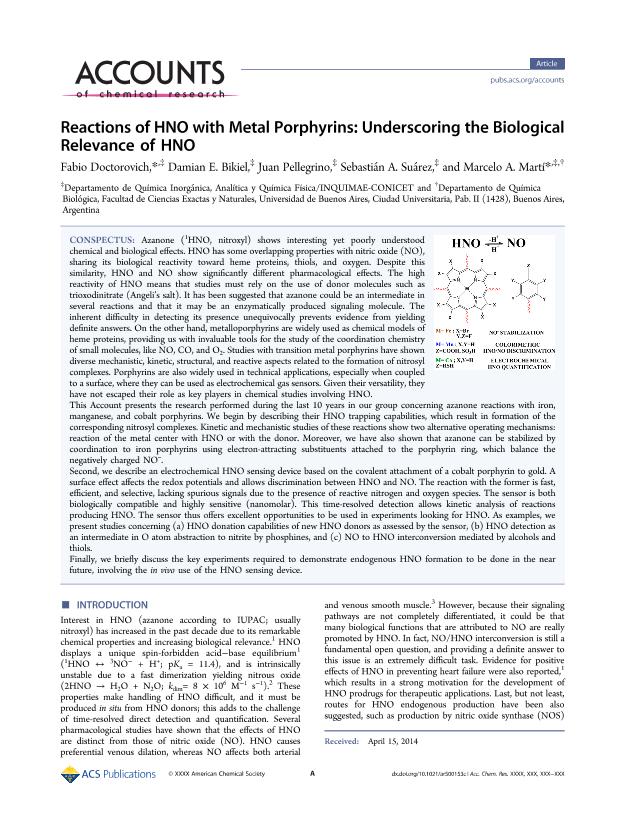Artículo
Reactions of HNO with Metal Porphyrins: Underscoring the Biological Relevance of HNO
Doctorovich, Fabio ; Bikiel, Damian Ezequiel
; Bikiel, Damian Ezequiel ; Pellegrino, Juan
; Pellegrino, Juan ; Suarez, Sebastian
; Suarez, Sebastian ; Marti, Marcelo Adrian
; Marti, Marcelo Adrian
 ; Bikiel, Damian Ezequiel
; Bikiel, Damian Ezequiel ; Pellegrino, Juan
; Pellegrino, Juan ; Suarez, Sebastian
; Suarez, Sebastian ; Marti, Marcelo Adrian
; Marti, Marcelo Adrian
Fecha de publicación:
09/2014
Editorial:
American Chemical Society
Revista:
Accounts of Chemical Research
ISSN:
0001-4842
Idioma:
Inglés
Tipo de recurso:
Artículo publicado
Clasificación temática:
Resumen
Azanone (1 HNO, nitroxyl) shows interesting yet poorly understood chemical and biological effects. HNO has some overlapping properties with nitric oxide (NO), sharing its biological reactivity toward heme proteins, thiols, and oxygen. Despite this similarity, HNO and NO show significantly different pharmacological effects. The high reactivity of HNO means that studies must rely on the use of donor molecules such as trioxodinitrate (Angeli’s salt). It has been suggested that azanone could be an intermediate in several reactions and that it may be an enzymatically produced signaling molecule. The inherent difficulty in detecting its presence unequivocally prevents evidence from yielding definite answers. On the other hand, metalloporphyrins are widely used as chemical models of heme proteins, providing us with invaluable tools for the study of the coordination chemistry of small molecules, like NO, CO, and O2. Studies with transition metal porphyrins have shown diverse mechanistic, kinetic, structural, and reactive aspects related to the formation of nitrosyl complexes. Porphyrins are also widely used in technical applications, especially when coupled to a surface, where they can be used as electrochemical gas sensors. Given their versatility, they have not escaped their role as key players in chemical studies involving HNO. This Account presents the research performed during the last 10 years in our group concerning azanone reactions with iron, manganese, and cobalt porphyrins. We begin by describing their HNO trapping capabilities, which result in formation of the corresponding nitrosyl complexes. Kinetic and mechanistic studies of these reactions show two alternative operating mechanisms: reaction of the metal center with HNO or with the donor. Moreover, we have also shown that azanone can be stabilized by coordination to iron porphyrins using electron-attracting substituents attached to the porphyrin ring, which balance the negatively charged NO¯. Second, we describe an electrochemical HNO sensing device based on the covalent attachment of a cobalt porphyrin to gold. A surface effect affects the redox potentials and allows discrimination between HNO and NO. The reaction with the former is fast, efficient, and selective, lacking spurious signals due to the presence of reactive nitrogen and oxygen species. The sensor is both biologically compatible and highly sensitive (nanomolar). This time-resolved detection allows kinetic analysis of reactions producing HNO. The sensor thus offers excellent opportunities to be used in experiments looking for HNO. As examples, we present studies concerning (a) HNO donation capabilities of new HNO donors as assessed by the sensor, (b) HNO detection as an intermediate in O atom abstraction to nitrite by phosphines, and (c) NO to HNO interconversion mediated by alcohols and thiols. Finally, we briefly discuss the key experiments required to demonstrate endogenous HNO formation to be done in the near future, involving the in vivo use of the HNO sensing device.
Palabras clave:
Hno
,
Nitroxyl
,
Porphyrin
,
Iron
,
Cobalt
,
Manganese
Archivos asociados
Licencia
Identificadores
Colecciones
Articulos(INQUIMAE)
Articulos de INST.D/QUIM FIS D/L MATERIALES MEDIOAMB Y ENERGIA
Articulos de INST.D/QUIM FIS D/L MATERIALES MEDIOAMB Y ENERGIA
Citación
Marti, Marcelo Adrian; Suarez, Sebastian; Pellegrino, Juan; Bikiel, Damian Ezequiel; Doctorovich, Fabio; Reactions of HNO with Metal Porphyrins: Underscoring the Biological Relevance of HNO; American Chemical Society; Accounts of Chemical Research; 47; 10; 9-2014; 2907-2916
Compartir
Altmétricas



